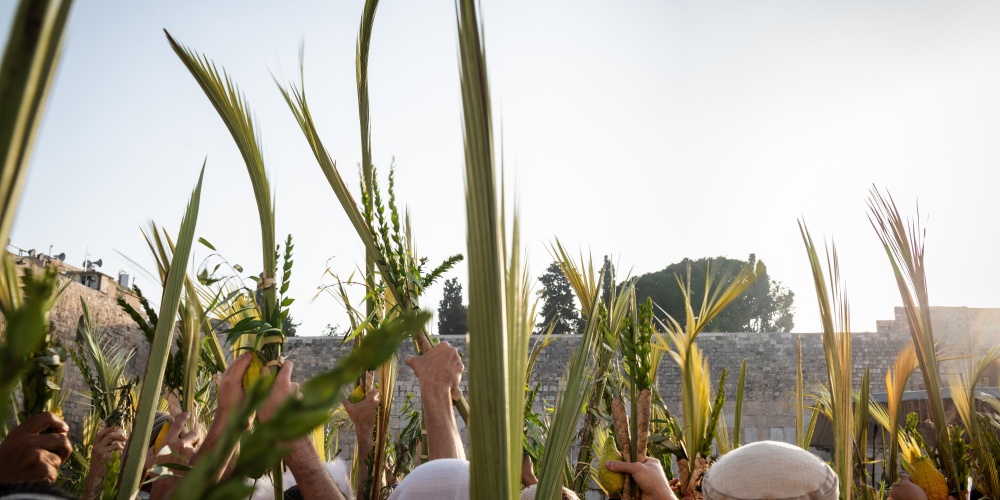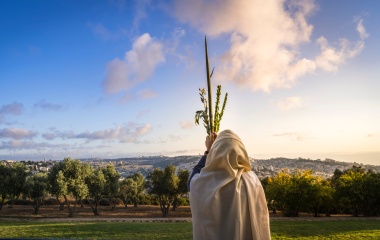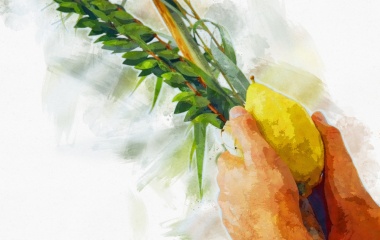
If asked which holiday Rosh Hashanah is most connected to, I think most of us would, for very good reason, answer Yom Kippur. Yet the Rambam – master codifier of Jewish law that he was – does no such thing. In sefer Zemanim, his book on the laws of festivals, Yom Kippur is given its own section. The laws of Shofar, described in three chapters is followed in chapters four-six with the laws of Sukkah and in chapters seven and eight with the laws of the Lulav. Clearly the Rambam is of the view that it is Sukkot that is the primary link to Rosh Hashana.
The shofar and the lulav are two ways in which we worship G-d. The shofaris meant to instil fear and trembling as G-d sits in judgement of man. “On the third day, as morning dawned, there was thunder, and lightning, and a dense cloud upon the mountain, and the sound of the shofar was very strong and all the people who were in the camp trembled” (Shemot 19:16).The Divine Revelation at Sinai was most powerful, awe inspiring and even fear inspiring.
Each year on Rosh Hashanah we are reminded that Creation itself is the daily manifestation of Divine Revelation. Rosh Hashanah, the day we commemorate creation, is a day of Yirat Hashem, “fear” of G-d. We blow the shofar – the rams horn reminding us of the many sacrifices Jews have made in the service of G-d – in the middle of the Amidah, as we stand before G-d in prayer, beseeching Him to save us. On Sukkot that fear has been transposed to divine love. We take the lulav and etrog and shake them as we sing and dance in joy during Hallel. “Praise the Lord, for He is good, His steadfast love is eternal” (Tehillim118:1).
How does that happen? How do we refocus our relationship with G-d from fear to love?
Whatever the Torah tells us about G-d is meant as a message about man. That is a natural corollary of having been created in the image of G-d. G-d’s 13 attributes of mercy – recited over and over and over again on Yom Kippur, the day we can come closest to G-d – are G-d’s directives on how man must act. “Just as He is merciful, you too should be merciful, just as He is gracious, you too shall be gracious” (Shabbat 133b).
Every mitzva between man and G-d has a parallel in a mitzva between man and man. “The reward for fasting is charity” (Brachot 6b). We fast on Yom Kippur to sensitize us to the needs of the hungry and then do something about it. Similarly, we sit in the Sukkah to have a taste of being homeless and then do something about it. Every ritual contains an ethical teaching. It was observing the former without the latter that so bothered our prophets. Four days ago, we read how “G-d saw their [the people of Ninveh] actions”. As our Sages note, He cared little about “their fasting and wearing sackcloth”.
These examples – which can be multiplied many times over – can help explain why we are celebrating Sukkot in Tishrei on the heels of Rosh Hashanah and Yom Kippur, rather than during the month of Nissan, when we left Egypt. “You shall dwell in Sukkot for seven days; every citizen of Israel is to dwell in booths, when I brought them out of the land of Egypt: I am the Lord your God” (Vayikra 23:42-43). The Torah clearly links the mitzva of Sukkah to the Exodus and hence, one would have thought that Sukkot should be celebrated in the month that we left Egypt, i.e. in Nissan. In other words, we should celebrate the seder in our Sukkot, doing exactly what our ancestors who actually left Egypt did. “The Israelites journeyed from Rameses [in Egypt] to Sukkot [1], about six hundred thousand men on foot, besides children… And they baked unleavened cakes of the dough that they had taken out of Egypt, for it was not leavened, since they had been driven out of Egypt and could not delay; nor had they prepared any provisions for themselves” (Shemot 12:37,39).
That is what might have been, yet the Torah specifically placed Sukkot during the month of Tishrei, immediately following Rosh Hashanah and Yom Kippur.
Rosh Hashanah and Yom Kippur are days we focus on our relationship with G-d. We spend many hours in prayer, acknowledge our divine Creator, and prepare for the day of Divine judgement. We re-enact the service of the High Priest in the Temple as we plead for forgiveness on the anniversary of the day that G-d forgave us for the sin of idolatry.
On Sukkot we focus not on our relationship with G-d, but with our fellow man. “'All the citizens of Israel shall reside in sukkot’: This teaches that all of the Jewish people are fit to reside in one sukkah” (Sukkah 27b). The lulav, etrog, hadas and arava symbolize different types of Jews, from the most pious to the most assimilated. And if that most assimilated Jew, symbolized by the arava, is not held next to the etrog, the etrog is just a strange looking lemon. It is on Sukkot we are told that we must rejoice with “the ger, stranger or convert, the orphan and the widow in your midst” (Devarim 16:14 ).
If Rosh Hashanah is primarily a day of tefillah, prayer, and Yom Kippur one of teshuva, repentance, Sukkot is the time of tzedakah, charity. We can now be confident that we “have annulled the evil of the decree” (Uneteneh Tokef).
The way we treat our fellow human beings is the best indicator of our belief in G-d. Being that everyone we interact with is created in the image of G-d, mistreating another is the way, pretty much the only way we can actively mistreat G-d.
During Rosh Hashanah and Yom Kippur we repair, renew and reinvigorate our relationship with G-d. But only on Sukkot do we see the full meaning of that relationship.
[1] While Sukkot here is a place not a hut, this beautiful “word play” just strengthens the link between Pesach and Sukkot. They dwelled in Sukkot at Sukkot and there they ate matza.



